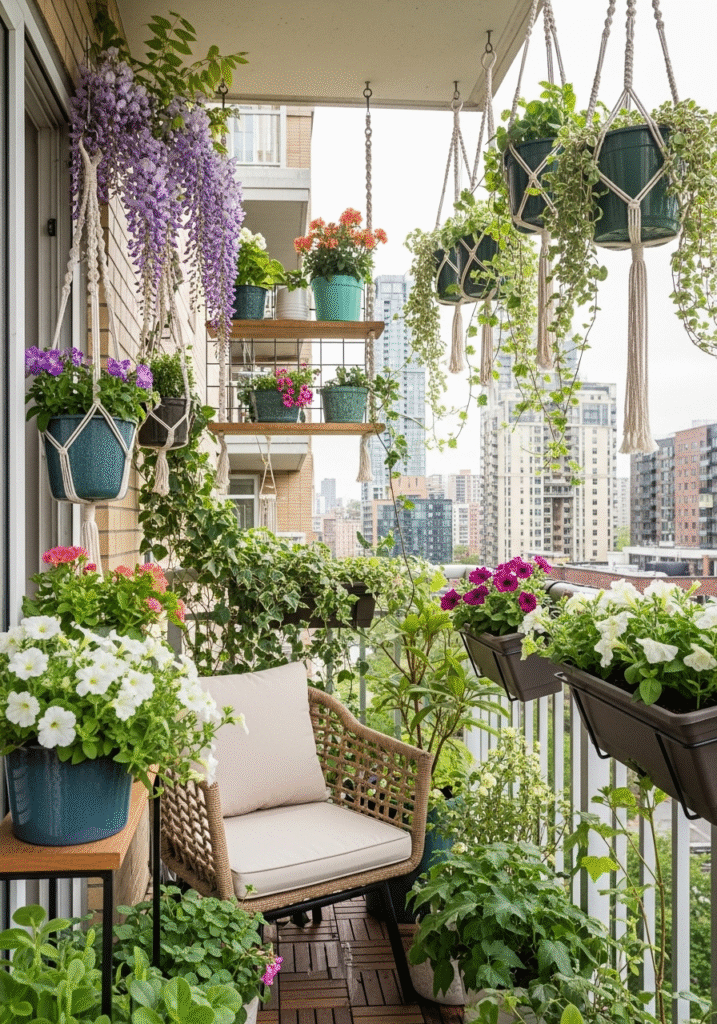Introduction
In today’s fast-paced urban life, having a cozy outdoor space—even a small balcony—can be a true blessing. It’s your personal corner to breathe, relax, sip a cup of tea, or read a book. But what if your balcony feels dull, bare, or uninspiring? That’s where hanging plants come to the rescue. These vertical green companions are one of the easiest and most beautiful ways to bring nature closer to you, even in the tightest of spaces.
Whether you’re living in a compact city apartment or enjoying the luxury of a spacious terrace, hanging plants can instantly transform any ordinary balcony into a lush, green sanctuary. Their cascading leaves, colorful blooms, and refreshing fragrance can breathe life into walls, railings, ceilings, or even floating shelves. They create a sense of calm and connection with nature, which is especially valuable in concrete-heavy surroundings.
But with so many plant options out there, you might be wondering: Which hanging plants are best for balconies? How do you choose ones that will thrive in your space’s light, humidity, and climate? And how can you display them creatively without overcrowding or damaging your walls?
This comprehensive guide has all the answers. We’ll walk you through 20+ inspiring hanging plant ideas that are perfect for balconies of all sizes. You’ll discover a mix of flowering vines, low-maintenance succulents, shade-loving greenery, and even edible options like herbs and strawberries. Plus, you’ll get smart tips on how to hang plants using railings, ceiling hooks, wall brackets, and DIY containers—along with easy care instructions to keep them thriving throughout the year.
Whether you’re a beginner plant parent or a seasoned gardener, these hanging plant ideas will help you:
- Maximize your vertical space
- Improve your balcony’s air quality and aesthetics
- Create a peaceful natural retreat that reflects your personality
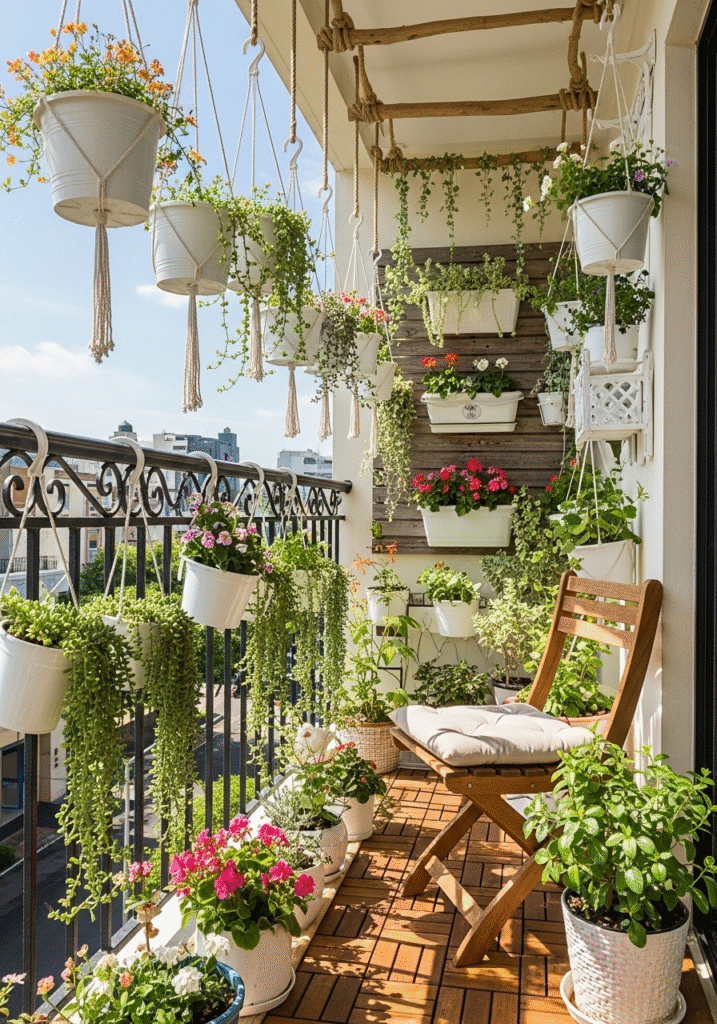
Why Hanging Plants Are Perfect for Balconies
Hanging plants are more than just decorative touches—they’re a practical, space-saving solution for modern living. Whether you’re dealing with a tiny urban balcony or a spacious terrace, vertical gardening with hanging plants offers multiple benefits that go beyond aesthetics. In fact, they are one of the most efficient ways to green up your space without sacrificing valuable floor area.
1. Maximize Vertical Space
One of the main reasons hanging plants are ideal for balconies is their ability to make the most of vertical space. In many apartment setups, floor space is limited or cluttered with furniture, making it difficult to create a traditional garden. Hanging planters, ceiling hooks, railing-mounted baskets, or even tiered stands allow you to grow a lush variety of plants without using any ground space. This vertical gardening approach is especially useful for renters or anyone living in compact apartments.
By hanging plants at different heights, you can add dimension, depth, and layers of greenery that elevate the overall look of your balcony. It’s like creating a mini jungle in the sky!
2. Create Natural Privacy Screens
Urban balconies often face neighboring apartments or streets, which can compromise your sense of privacy. But with the right selection of hanging plants, you can create a natural green screen that acts as a visual barrier. Dense foliage plants like Boston fern, English ivy, or money plant (pothos) work beautifully as natural curtains that filter light and block views—without closing you off entirely from fresh air and sunlight.
This natural privacy doesn’t just shield you from outside eyes; it also adds a cozy, intimate vibe to your balcony space.
3. Improve Air Quality
Hanging plants don’t just look good—they also feel good to be around. Many popular hanging varieties are known for their air-purifying qualities. Plants like spider plants, pothos, peace lilies, and philodendrons can help absorb pollutants, filter toxins, and boost oxygen levels in the surrounding environment.
Whether your balcony is open-air or semi-enclosed, these plants can improve the overall air quality while making your space healthier and more enjoyable. This is especially valuable in urban environments where pollution levels tend to be higher.
4. Add Instant Aesthetic Appeal
There’s something undeniably charming about a balcony adorned with trailing vines, vibrant blooms, or cascading green leaves. Hanging plants introduce color, texture, and life into an otherwise plain space. From the delicate tendrils of string of pearls to the lush foliage of philodendron, each plant brings its own personality and visual impact.
You can mix and match plants to create contrast and harmony—pair variegated leaves with colorful flowers, or combine thick succulents with airy ferns for a diverse look. With the right placement and containers, your balcony can become a stunning extension of your indoor décor.
5. Enjoy Low-Maintenance Gardening
If you love the idea of greenery but don’t have the time (or experience) for high-maintenance gardening, don’t worry—there are plenty of low-maintenance hanging plants that are perfect for balconies. Plants like succulents, pothos, wandering jew, and string of hearts require minimal watering and can tolerate a range of light conditions.
These plants are great for beginners or busy homeowners who want to enjoy a lush green environment without the stress of daily care. As long as you choose the right plants for your specific light and climate, your hanging garden can thrive with very little effort.
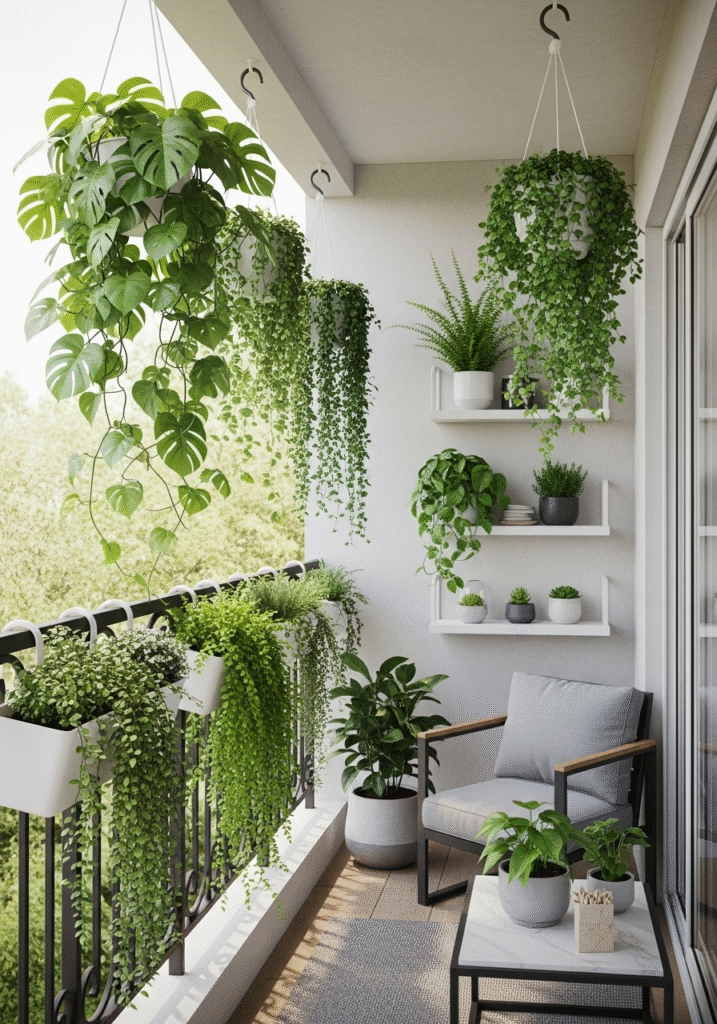
Factors to Consider Before Choosing Hanging Plants
While hanging plants can instantly uplift the look and feel of your balcony, selecting the right ones requires a bit of planning. Not all plants thrive in the same conditions, and balconies often come with unique environmental challenges like strong winds, limited sunlight, or seasonal extremes. To ensure your vertical garden flourishes and stays healthy, it’s essential to understand the key factors that influence plant growth.
Here are the most important considerations to keep in mind before you invest in hanging plants for your balcony:
1. Sunlight Exposure
The amount and direction of sunlight your balcony receives is one of the most critical factors when choosing hanging plants.
- South-facing balconies tend to receive the most sunlight throughout the day, making them perfect for sun-loving plants like petunias, lantanas, and succulents.
- East-facing balconies get soft morning sunlight, which is ideal for delicate plants like ferns or impatiens that prefer indirect light.
- West-facing balconies may get harsh afternoon sun, so choose hardy plants like geraniums or portulaca that can handle the heat.
- North-facing balconies often remain in the shade or receive very little direct sunlight. In such cases, go for low-light plants such as pothos, English ivy, or spider plants.
Knowing your balcony’s sun pattern will help you select plants that are naturally adapted to thrive in that light condition, reducing the risk of wilting or leaf burn.
2. Wind Exposure and Protection
If you live in a high-rise building or an area with strong winds, this can significantly impact your plant’s health and safety. Wind can dry out soil quickly, break fragile stems, and even cause hanging pots to swing or fall.
To counter this:
- Choose sturdy, wind-resistant plants like trailing rosemary, ivy, or succulents with compact growth.
- Use heavy-duty planters or secure hanging systems with proper hooks and brackets to prevent accidents.
- Consider adding a wind barrier, such as a trellis or mesh screen, to provide some protection without blocking all airflow.
Wind can be subtle yet damaging over time, so don’t underestimate its effects—especially for balconies on higher floors.
3. Water Drainage and Maintenance
Proper drainage is essential for the health of any hanging plant. Without it, excess water can accumulate in the planter, leading to root rot, mold growth, or even pest infestations.
Here’s what to keep in mind:
- Always use hanging pots or containers that have drainage holes at the bottom.
- Consider adding a saucer or liner underneath to catch drips, especially if your balcony has wooden or tiled flooring.
- Use well-draining potting soil suited to the type of plant (e.g., cactus soil for succulents, moisture-retaining soil for ferns).
- During summer or dry months, hanging plants may dry out faster, so regular watering is a must. Choose plants based on how much attention you can realistically give them.
Tip: Use self-watering hanging planters if you’re away often or have a busy schedule.
4. Plant Type and Purpose
Your plant selection should also reflect your lifestyle, aesthetic goals, and functional needs. Not all hanging plants serve the same purpose, so consider what you’re hoping to achieve with your balcony garden:
- Flowering plants like petunias, fuchsias, and begonias add vibrant color and seasonal beauty.
- Foliage plants such as ferns, pothos, and philodendrons bring lush greenery and texture.
- Succulents and cacti like string of pearls or burro’s tail are perfect for low-maintenance and modern aesthetics.
- Herbs such as basil, mint, and thyme provide fresh ingredients for your kitchen while being easy to grow in hanging baskets.
- Vines like morning glory, mandevilla, or jasmine add drama with their trailing or climbing growth.
Think about mixing different plant types to achieve a more dynamic and functional balcony garden.
5. Climate and Seasonal Changes
Your local climate and seasonal temperature changes play a big role in determining which hanging plants will thrive. Some plants love the sun and warmth but can’t survive the winter chill, while others are more cold-tolerant but don’t fare well in heat.
- In hot and dry climates, opt for drought-tolerant plants like succulents or portulaca.
- In humid or tropical regions, plants like ferns, pothos, and orchids can do well.
- For colder regions, either bring your hanging plants indoors during winter or choose cold-hardy varieties like certain ivies and ornamental grasses.
Check your USDA Hardiness Zone or local gardening guidelines to match plant species with your region’s climate. It’s also smart to choose perennials if you want plants that return year after year, or annuals if you prefer to change your display seasonally.
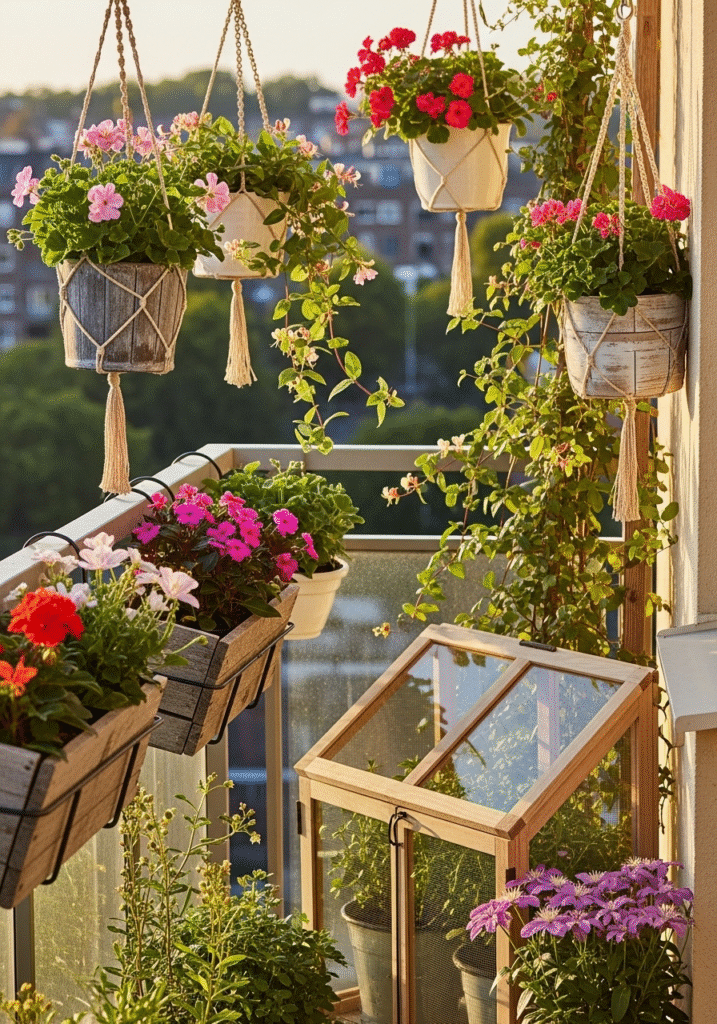
Best Hanging Plants for Balcony Gardens
When it comes to balcony gardening, hanging plants are a game-changer. They allow you to decorate vertically, save space, and add visual interest from top to bottom. The best part? Many of the most beautiful hanging plants are surprisingly easy to care for. Whether your balcony gets full sun, partial shade, or barely any light, there’s a hanging plant that’s perfect for your space.
Here are 10 of the best low-maintenance hanging plants to brighten up your balcony:
1. Spider Plant (Chlorophytum comosum)
Spider plants are one of the most popular indoor and balcony hanging plants for good reason. They’re incredibly easy to grow, tolerate a variety of conditions, and produce “babies” or plantlets that dangle beautifully from the mother plant. These plants are also known for their air-purifying qualities, removing toxins like carbon monoxide and formaldehyde from the air.
- Light: Bright, indirect light or partial shade
- Water: Moderate watering, allowing soil to dry out slightly between waterings
- Ideal for: Shaded or semi-shaded balconies
2. Petunias
Looking to add a pop of vibrant color to your balcony? Petunias are your go-to flowering hanging plants. They bloom generously in rich shades of purple, red, pink, and white, creating a lively and cheerful atmosphere. Petunias love the sun and do particularly well in warm climates, making them ideal for sunny balconies in spring and summer.
- Light: Full sun (6–8 hours a day)
- Water: Keep soil moist but not soggy
- Ideal for: Bright, sunlit balconies
3. English Ivy (Hedera helix)
English ivy is a fast-growing climber that can be trained to trail down beautifully from hanging baskets or railing planters. It’s a great plant for adding privacy and coverage, and its lush green foliage creates a cooling, natural curtain for balconies exposed to neighbors or streets.
- Light: Tolerates low to bright indirect light
- Water: Keep soil consistently moist
- Ideal for: Cooler, partially shaded balconies
4. Golden Pothos (Epipremnum aureum)
Also known as money plant or devil’s ivy, pothos is one of the easiest and hardiest hanging plants you can grow. It features heart-shaped, variegated leaves that trail beautifully, and it can thrive in a variety of lighting conditions. Pothos also purifies the air and requires very little maintenance, making it perfect for beginners.
- Light: Indirect light or low light
- Water: Let soil dry out between waterings
- Ideal for: Indoor balconies or those with low sunlight
5. Fuchsia
If you’re aiming for a more whimsical or romantic balcony garden, fuchsia plants are a wonderful choice. Known for their bell-shaped, drooping flowers in shades of pink, purple, and red, these plants are a magnet for hummingbirds and butterflies. Fuchsias prefer cooler temperatures and partial shade, making them ideal for east-facing or north-facing balconies.
- Light: Bright but indirect sunlight
- Water: Needs regular watering, especially in summer
- Ideal for: Semi-shaded, breezy balconies
6. String of Pearls
This eye-catching succulent is named for its round, bead-like leaves that trail down in elegant strands. It’s a fantastic modern plant that adds architectural interest to your balcony decor. String of Pearls thrives in dry climates and does best when left alone, making it perfect for busy gardeners.
- Light: Bright, indirect light or filtered sun
- Water: Water sparingly; allow soil to dry completely
- Ideal for: Dry, sunny balconies or covered outdoor spaces
7. Ferns (Boston or Maidenhair)
Ferns bring lush, delicate greenery that instantly softens and freshens any balcony. The Boston fern is particularly popular for hanging planters, with its arched fronds and full, bushy growth. Maidenhair ferns, on the other hand, offer a more airy and graceful appearance.
- Light: Indirect sunlight or shade
- Water: Keep soil evenly moist and mist leaves in dry air
- Ideal for: Cool, shaded balconies with some humidity
8. Begonias
Begonias are versatile hanging plants that come in a wide range of leaf shapes and vibrant flower colors. They bloom continuously during the warm seasons and are well-suited to hanging baskets. With both flowering and foliage varieties available, you can mix and match for a layered, colorful look.
- Light: Partial sun or filtered light
- Water: Moist soil; avoid overwatering
- Ideal for: Balconies with morning sun or partial shade
9. Wandering Jew (Tradescantia zebrina)
With its striking purple and green striped leaves, the wandering jew adds a bold, colorful accent to your balcony. This trailing plant grows quickly and creates a lovely cascading effect over the edges of planters or shelves. It’s a great option for filtered sunlight or bright indoor areas.
- Light: Bright, indirect light
- Water: Water when top inch of soil is dry
- Ideal for: Partially shaded or east-facing balconies
10. Nasturtium
If you want something that’s both edible and ornamental, nasturtiums are a perfect choice. These fast-growing plants produce vibrant flowers in shades of yellow, red, and orange, and their leaves and blooms are both edible—great for salads or garnishes. They also attract pollinators like bees and butterflies.
- Light: Full sun to light shade
- Water: Moderate; avoid overwatering
- Ideal for: Sunny balconies or railing planters
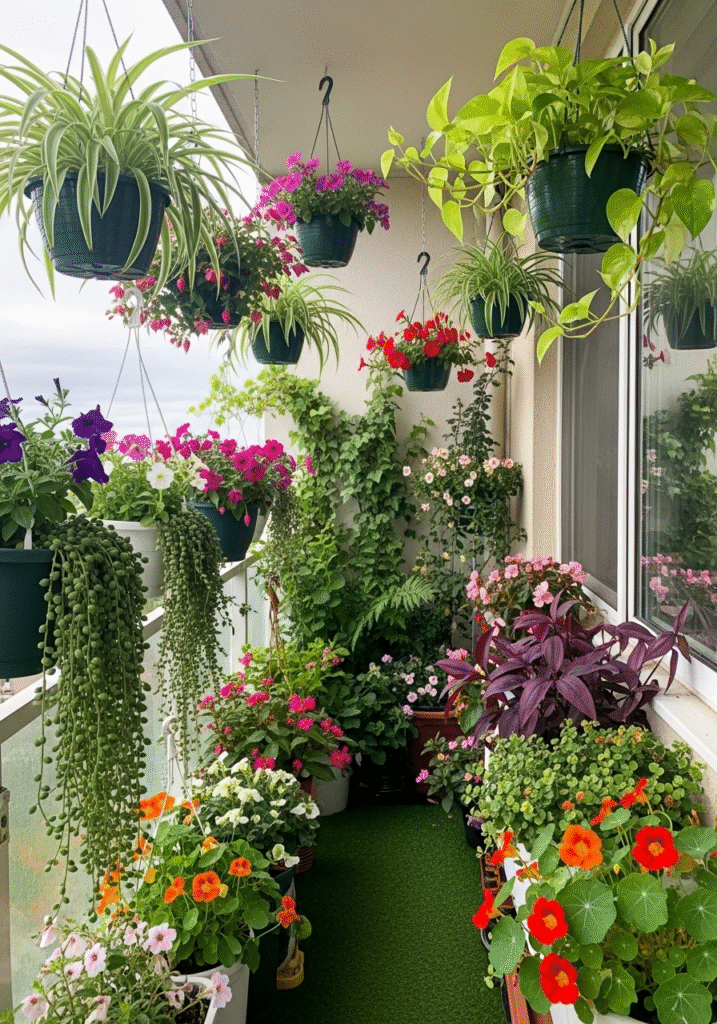
Creative Hanging Ideas for Small Balconies
You don’t need a spacious terrace or rooftop garden to enjoy the beauty of hanging plants. Even the tiniest balcony can become a lush, stylish retreat with the right hanging methods. The key lies in using smart, space-saving, and visually appealing ways to display your plants—especially when floor space is limited. With a touch of creativity and a few practical tools, you can turn your small balcony into a vibrant vertical garden.
Here are some of the most innovative and renter-friendly ideas for hanging plants on small balconies:
🌿 1. Macramé Hangers for a Boho Vibe
Macramé plant hangers are one of the most popular and aesthetically pleasing options for balconies of any size. These woven, rope-like holders not only suspend your plants from above but also add a touch of bohemian charm to your outdoor space. You can hang them from ceiling hooks, curtain rods, or even a mounted bracket.
They come in various lengths, styles, and patterns, allowing you to display multiple plants at varying heights. The best part? They’re lightweight and easy to swap out whenever you want to redecorate.
- Best for: Small potted plants like pothos, spider plant, or ferns
- Where to hang: Ceiling hooks, overhead rods, or sturdy balcony beams
🌿 2. Rail Planters for Function and Privacy
If your balcony has a railing, you already have a built-in space for hanging planters. Rail planters hook directly over the railing, making them perfect for displaying trailing plants or blooming flowers. In addition to saving floor space, they can also serve as a natural privacy screen, shielding your balcony from street views or nearby neighbors.
Choose long trough-style planters for a uniform look or mix and match smaller hanging pots for a more eclectic garden wall.
- Best for: Petunias, nasturtiums, ivy, or herbs
- Where to hang: Balcony railings, fencing, or balcony edges
🌿 3. Vertical Wall Frames or Plant Grids
Walls are often overlooked in balcony design, but they offer an incredible opportunity for vertical gardening. Install a metal or wooden wall grid, vertical pallet, or trellis where you can attach small pots in a grid or staggered pattern. This approach not only maximizes vertical space but also creates an eye-catching green feature wall.
You can use s-hooks, zip ties, or mini shelves to hold the pots securely. Add fairy lights or decorative elements to make it even more charming.
- Best for: Herbs, succulents, or small flowering plants
- Where to mount: Exterior balcony walls or wooden panels
🌿 4. Repurposed Items for DIY Charm
Add personality and eco-friendly charm to your balcony by repurposing household items into hanging planters. Old mugs, teacups, tin cans, mason jars, kitchen colanders, or vintage lanterns can all be transformed into creative plant holders with a little paint and imagination.
These DIY planters can be hung with rope, wire, or chain and make for a whimsical, budget-friendly display. They’re a great way to showcase your creativity while reducing waste.
- Best for: Herbs, mini succulents, or trailing vines
- Where to hang: Walls, railings, or hooks
🌿 5. Hanging Wooden Shelves
If you have a bare balcony corner or vertical beam, consider installing hanging wooden shelves supported by ropes or chains. These multi-tiered shelves are ideal for displaying several small potted plants without crowding the floor. The layering effect also helps you create visual depth while keeping your greenery organized and accessible.
Floating shelves can be hung from the ceiling or balcony walls, and they’re easy to customize with stain, paint, or distressing to match your decor.
- Best for: Grouping small pots like succulents, ferns, or begonias
- Where to hang: Wall-mounted hooks, rods, or balcony beams
🌿 6. Ceiling Hooks and Rods for Cascading Plants
If your balcony has a covered ceiling or overhang, make use of that space by installing ceiling hooks or curtain rods. This allows you to hang multiple baskets or macramé planters that create a cascading garden effect. Plants like string of pearls, golden pothos, or fuchsias will trail down beautifully and create an immersive green canopy.
This setup is especially effective for narrow balconies where wall and floor space is limited.
- Best for: Long trailing plants or dramatic flowering vines
- Where to hang: Balcony ceiling, beams, or crossbars
🌿 7. Over-the-Door Hooks – Perfect for Renters
If you’re renting and can’t drill into walls or ceilings, over-the-door hooks offer a clever, no-damage solution. These hooks can be placed over balcony doors or railing edges to hold hanging baskets, small shelf brackets, or even plant hangers. They’re inexpensive, removable, and widely available.
This option makes it easy to enjoy a hanging garden without making permanent changes to the property.
- Best for: Lightweight pots and beginner-friendly plants
- Where to hang: Over doors, railing frames, or even closet-style panels on your balcony
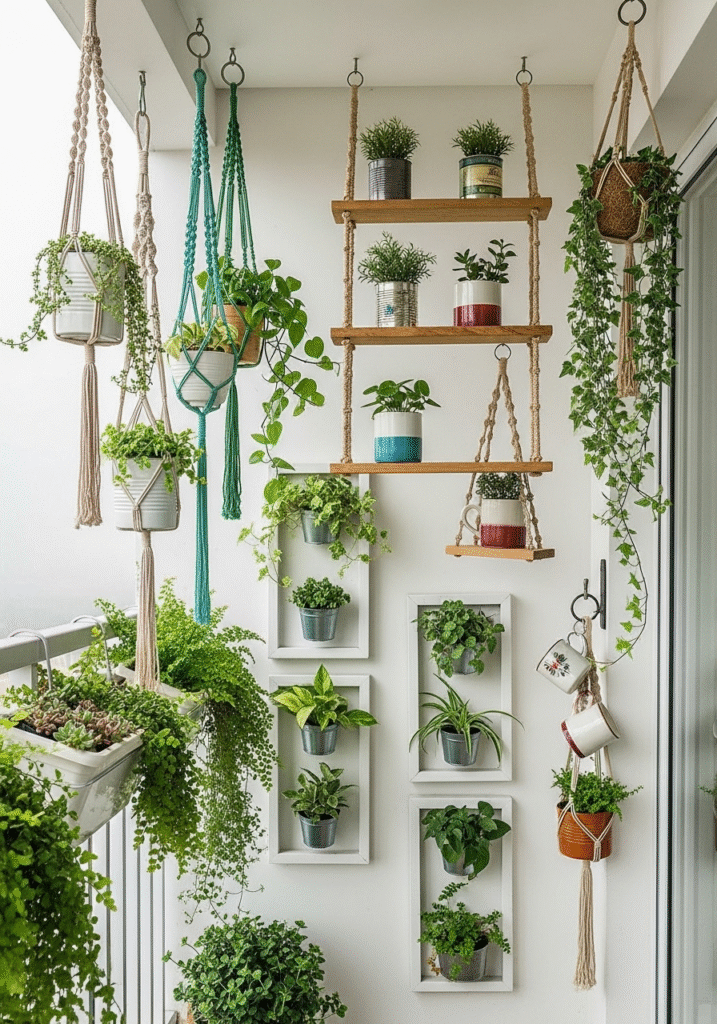
DIY Hanging Planter Options
Creating a beautiful balcony garden doesn’t have to come with a hefty price tag. In fact, some of the most charming and personalized hanging planters are ones you can make yourself—often using materials you already have at home. These DIY hanging planter ideas are not only budget-friendly, but they’re also eco-conscious, customizable, and perfect for adding a personal touch to your green space.
Whether you’re an experienced DIYer or just getting started, these planter options are simple, stylish, and suited for balconies of all sizes. Let’s explore how you can turn everyday items into stunning hanging garden displays.
♻️ 1. Plastic Bottle Planters
One of the easiest and most accessible ways to create a hanging planter is by reusing plastic bottles. Instead of throwing them away, cut them into desired shapes, poke a few holes for drainage, and decorate them with paint, washi tape, or stickers. You can hang them using string, jute rope, or wire.
These eco-friendly planters are great for small plants and herbs and can be hung along balcony railings or mounted to walls. You can even align several bottles vertically to make a cascading garden display.
- Ideal for: Herbs, succulents, or small flowering plants
- Skill level: Beginner
- Materials needed: Empty plastic bottles, scissors, paint, string/rope, nail or awl for drainage holes
🥫 2. Tin Can Hangers
Old food cans (like those from beans or soups) can be transformed into rustic, industrial-style planters with just a bit of effort. Clean the cans thoroughly, punch or drill a few drainage holes in the bottom, and paint or wrap them in burlap, fabric, or twine for added style. Use jute rope, wire, or chains to create hangers.
This DIY project adds a charming farmhouse touch to your balcony and is incredibly cost-effective.
- Ideal for: Trailing plants or decorative foliage
- Skill level: Beginner to intermediate
- Materials needed: Empty tin cans, drill, paint or wrap, rope or chain for hanging
🥥 3. Coconut Shell Planters
If you’re looking for a natural and sustainable planter option, coconut shells are a beautiful and biodegradable choice. After cutting and cleaning the shell, you can drill holes for drainage and attach strings to hang them from ceiling hooks or balcony beams.
Coconut planters have a raw, tropical aesthetic and are perfect for small plants. They’re also lightweight and great for minimalist or nature-inspired balcony designs.
- Ideal for: Ferns, mosses, or mini succulents
- Skill level: Intermediate (requires cutting coconut shell safely)
- Materials needed: Coconut shells, drill, rope or twine, optional paint or sealant
🫙 4. Mason Jar Wall Planters
Mason jars are beloved for their versatility, and they make excellent hanging planters—especially when attached to a wooden plank or pallet to create a vertical wall garden. You can screw metal clamps onto a wooden board, slide the jars in, and hang the board on your balcony wall. For better plant health, add small stones at the bottom for drainage if you’re not drilling holes.
These planters add a cozy, rustic farmhouse vibe and are ideal for balconies that receive indirect sunlight.
- Ideal for: Herbs, mini flowers, or water-rooting cuttings
- Skill level: Intermediate (requires tools like clamps and screws)
- Materials needed: Mason jars, wooden board, metal clamps, screws, pebbles
🧺 5. Old Basket Hangers
Give new life to old fruit, storage, or picnic baskets by turning them into charming hanging planters. Baskets naturally allow airflow and drainage, making them ideal for plant roots. Simply line the basket with coconut coir or landscape fabric to hold the soil, then add your plants and hang using rope or macramé holders.
This is a great way to add texture and warmth to your balcony garden, and it works wonderfully for trailing plants like ivy, sweet potato vine, or golden pothos.
- Ideal for: Cascading vines and flowering plants
- Skill level: Beginner
- Materials needed: Woven baskets, liner (coco coir or cloth), rope for hanging
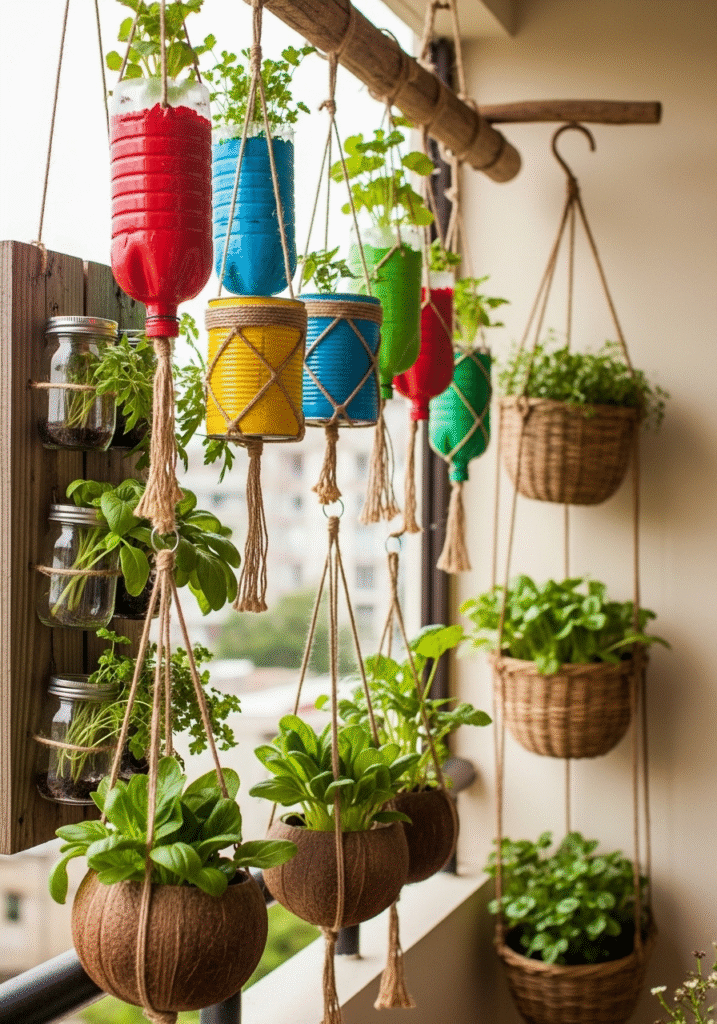
Maintenance Tips for Balcony Hanging Plants
Once you’ve set up your balcony with beautiful hanging plants, the next step is keeping them healthy and thriving. Thankfully, plant care doesn’t have to be complicated—especially if you choose the right varieties and develop a consistent routine. With just a little attention and love, your balcony can remain green and vibrant all year round.
Hanging plants do have slightly different care requirements than ground-level plants. They’re more exposed to the elements—sun, wind, and heat—which means they may need a bit of extra care, particularly when it comes to watering and feeding. Whether you’re a beginner or an experienced gardener, these simple yet effective maintenance tips will help you nurture your hanging garden with confidence.
💧 1. Watering: Keep It Consistent and Timely
Hanging planters tend to dry out faster than in-ground or potted plants because they have less soil volume and more exposure to air circulation. As a result, regular and proper watering is essential.
- Tip: Water your plants early in the morning or late in the evening, when the sun is not too strong. This reduces evaporation and gives roots time to absorb moisture effectively.
- Use a watering can with a narrow spout or a hose with a gentle nozzle to avoid splashing soil out of the planter.
- During hot summer months, you may need to water once daily. In cooler or more humid seasons, check the soil moisture with your finger before watering.
- Consider using self-watering planters or adding water-retaining crystals to the soil mix for extra convenience.
🌱 2. Feeding: Use the Right Fertilizer at the Right Time
To keep your hanging plants lush and blooming, they’ll need occasional feeding—especially during the active growing season (spring and summer). Limited soil in hanging baskets means nutrients get used up quickly, so feeding becomes crucial for continued health.
- Use a slow-release granular fertilizer every 4–6 weeks, which gradually feeds the plant over time.
- Alternatively, apply a liquid fertilizer diluted in water every 2–3 weeks for a quick nutrient boost.
- Choose fertilizers based on plant type: flowering plants benefit from phosphorus-rich formulas, while leafy greens or ferns do well with nitrogen-rich blends.
Avoid over-fertilizing, as it can lead to burnt roots and leggy growth. Always follow label instructions carefully.
✂️ 3. Pruning: Trim for Health and Beauty
Regular pruning not only keeps your hanging plants looking neat and tidy but also promotes new growth and more blooms. Dead, yellowing leaves and faded flowers drain energy from the plant—removing them helps redirect nutrients to healthy parts.
- Use clean, sharp scissors or pruning shears to remove dead or damaged leaves.
- Pinch back leggy or overgrown stems to encourage fuller growth and bushier appearance.
- For flowering plants, perform deadheading (removing spent blooms) to extend the blooming period.
Make pruning a regular part of your plant care routine—every couple of weeks is often enough, depending on plant type.
🪴 4. Re-potting: Refresh the Roots Annually
Most hanging plants grow quickly and can become root-bound—when roots outgrow the pot and circle tightly, restricting nutrient uptake. This leads to stunted growth, yellow leaves, or wilting despite watering.
- Re-pot your hanging plants once a year, ideally in early spring before the growing season starts.
- Choose a slightly larger container and refresh the potting mix with fresh, nutrient-rich soil.
- Gently loosen the root ball before placing the plant into the new container to help roots spread.
Re-potting not only revives the plant but also allows you to inspect for any root rot or pests hiding in the soil.
🐛 5. Pest Control: Stay One Step Ahead
Because hanging plants are elevated and sometimes tucked away, pests can go unnoticed until they cause significant damage. Common balcony plant pests include aphids, spider mites, and mealybugs.
- Check under leaves and around stems regularly for signs of infestation, such as sticky residue, webbing, or tiny moving insects.
- If pests are detected, remove them with a gentle stream of water or wipe leaves with a cloth dipped in soapy water.
- For stubborn pests, use organic insecticidal soap or neem oil spray.
- Isolate new plants for a few days before adding them to your balcony garden to avoid spreading potential pests.
Early detection and natural treatments usually prevent larger infestations and reduce the need for chemical intervention.
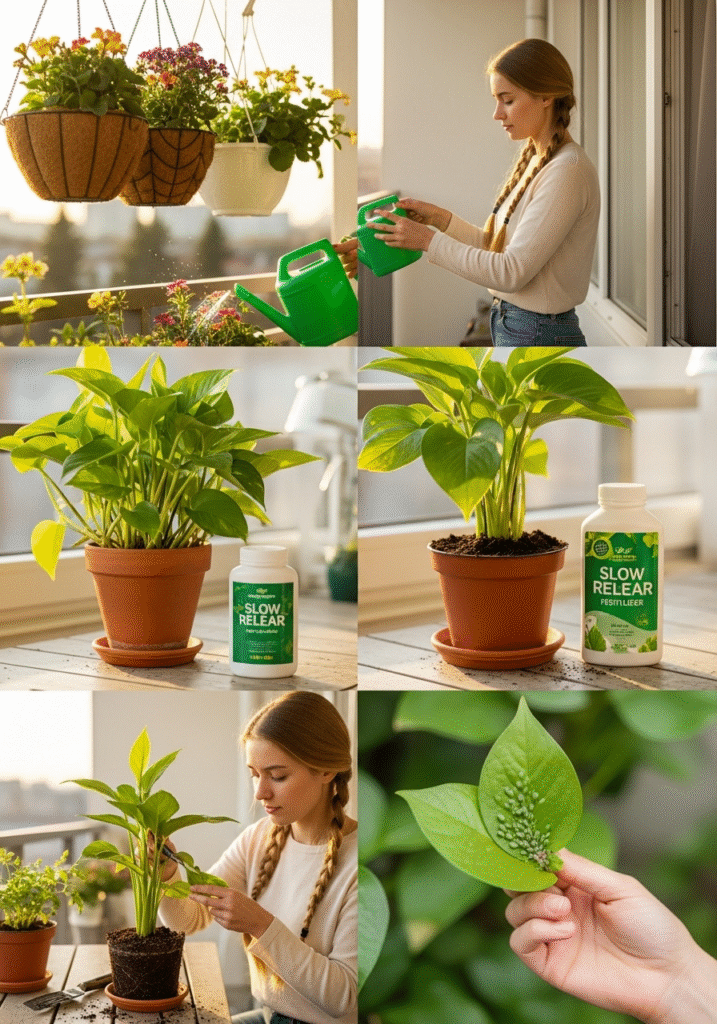
Seasonal Plant Suggestions
When planning a hanging balcony garden, it’s essential to think seasonally. Just like clothing, plants have their own seasonal preferences. Some varieties thrive in the warm sunshine of summer, while others flourish in the cooler days of spring or autumn. Choosing plants based on the current season not only helps them thrive naturally but also ensures your balcony stays vibrant and full of life all year long.
Understanding which plants to grow in each season allows you to rotate your balcony garden strategically, enjoy seasonal blooms, and protect delicate plants from damage due to extreme weather. Here’s a breakdown of the best hanging plants for each season, along with helpful tips for changing conditions.
Spring: A Time to Refresh and Replant
Spring marks the beginning of the growing season. As temperatures rise and daylight increases, plants begin to bloom, and it’s the perfect time to rejuvenate your balcony garden. Hanging plants that thrive in spring are typically vibrant, fast-growing, and full of life.
- Nasturtiums: These edible flowers are easy to grow and come in bright hues of orange, yellow, and red. Their trailing vines look beautiful in hanging baskets, and they also help repel garden pests.
- Lobelia: Known for their delicate, cascading blue, purple, or white flowers, lobelias are perfect for adding a cool, airy feel to your balcony during spring.
- Verbena: A colorful flowering plant that attracts butterflies and blooms from spring through fall. It thrives in containers and loves plenty of sunlight.
Care Tip: Start fertilizing lightly in early spring and gradually increase as the season progresses. Keep an eye on sudden temperature drops during late frosts.
Summer: Celebrate the Sun
Summer is peak season for many flowering and sun-loving hanging plants. Long days and warmer temperatures create ideal conditions for vibrant blooms and trailing foliage, especially in south- or west-facing balconies that get full sun exposure.
- Petunias: These are summer favorites for their nonstop blooming, wide color range, and ease of care. Ideal for hanging baskets, petunias are heat-tolerant and bring vibrant energy to any space.
- Geraniums: Especially suited for hot, dry balconies, geraniums are drought-tolerant, long-blooming, and come in bright reds, pinks, and whites.
- Bougainvillea: For balconies in hot and dry climates, bougainvillea offers unmatched tropical flair. Its papery, vivid bracts come in pink, orange, purple, and white, and its trailing vines make it perfect for hanging displays.
Care Tip: Summer plants need more frequent watering—sometimes daily—especially in hanging containers that dry out quickly. Add mulch or coir liners to help retain moisture.
Autumn: Transition with Texture and Warm Tones
As temperatures begin to cool, autumn offers a chance to change up your plant palette with rich colors, textured leaves, and plants that thrive in milder conditions. This is also a great time to prepare your garden for winter.
- Marigold: These bold orange and yellow blooms are iconic for fall. Easy to grow, they add warmth to your balcony and can continue blooming well into early winter in mild climates.
- Coleus: Grown for its spectacular foliage rather than flowers, coleus comes in shades of burgundy, lime, and bronze—perfect for the autumn season.
- English Ivy: A hardy trailing plant that does well year-round but especially thrives in cooler weather. Its dense foliage makes it a great option for creating seasonal privacy screens or green drapes.
Care Tip: Reduce watering frequency as temperatures cool. Remove summer annuals that are fading and replace them with cool-season options.
Winter: Keep It Green in Mild Climates
Even in winter, your balcony doesn’t have to look barren—especially if you live in a region with mild winters. While freezing temperatures can be harsh on many hanging plants, there are several varieties that continue to thrive through the colder months, bringing greenery and life to an otherwise dull landscape.
- English Ivy: Evergreen and resilient, this plant can withstand cold temperatures and continues growing even in low light.
- Ferns (like Boston Fern): With their lush, feathery fronds, ferns maintain texture and greenery during winter if kept protected from frost.
- Pothos: An incredibly forgiving indoor/outdoor hanging plant that adapts well to winter conditions when brought indoors or placed in sheltered outdoor corners.
Care Tip for Cold Climates: If you experience frost or freezing temperatures, bring delicate hanging plants indoors or into a covered space. Use frost cloths or protective plant sleeves if you want to keep hardier plants outside.
General Tip: Rotate and Protect Your Plants by Season
To keep your balcony garden thriving all year:
- Rotate sun-loving plants to shade when needed.
- Move sensitive plants indoors during winter or extreme summer heat.
- Adjust your watering and feeding routine based on the weather.
- Use seasonal planters and lightweight hanging baskets so you can move them easily.
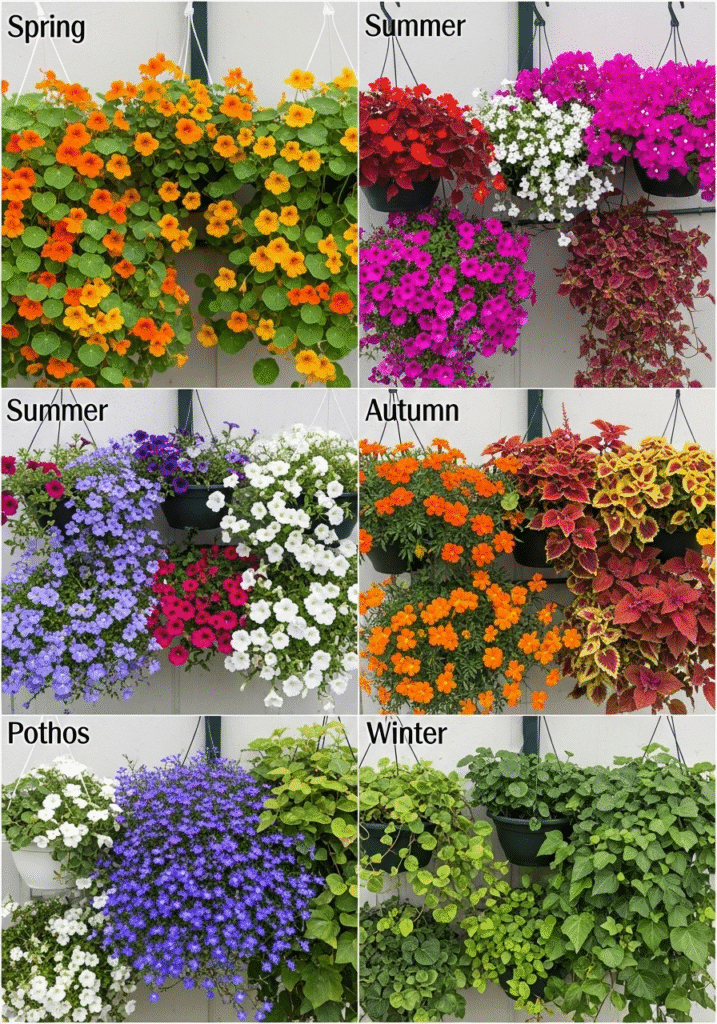
Common Mistakes to Avoid
While balcony gardens can be incredibly rewarding and visually stunning, they also come with unique challenges—especially when it comes to hanging plants. Many beginners (and even experienced gardeners) make simple but critical mistakes that can affect plant health, aesthetics, and even safety. The good news is that these issues are easy to prevent with the right knowledge.
In this section, we’ll explore the most common balcony gardening mistakes, particularly those related to hanging planters, and show you how to avoid them. These insights will help you build a garden that’s not only beautiful but also sustainable and stress-free.
1. Overwatering – The #1 Cause of Root Rot
Watering is vital—but more is not always better. One of the most frequent mistakes in hanging planter care is overwatering, especially when using containers that lack proper drainage holes. Excess water sits in the bottom of the planter, causing the roots to rot, leading to yellowing leaves, mold, and plant death.
- Avoid this mistake by:
- Ensuring all hanging planters have drainage holes at the bottom.
- Using well-draining potting soil, particularly for succulents or herbs.
- Watering only when the top inch of soil feels dry (use your finger to check).
- Placing saucers or drip trays underneath planters to protect your balcony floor without drowning the plant.
Remember: It’s easier to recover from underwatering than from waterlogged roots.
2. Too Much Sun Exposure – Not All Plants Love Full Sun
While sunlight is essential for plant growth, too much direct exposure—especially in summer—can scorch delicate leaves, causing wilting or brown spots. Many gardeners place all their plants in the sunniest corner of the balcony, assuming it’s beneficial. But not every plant thrives in full sunlight.
- Avoid this mistake by:
- Observing your balcony’s sunlight pattern (morning sun is gentler than afternoon sun).
- Choosing plants based on their light preferences—some love full sun (like petunias), while others prefer partial shade (like ferns or pothos).
- Providing shade using sheer curtains, umbrellas, or shade cloths when needed.
- Rotating your planters every few days to prevent uneven sun damage.
The right balance of sunlight ensures vibrant growth without stress or burns.
3. Ignoring Wind Exposure – The Silent Plant Killer
Balconies, especially on higher floors, can be exposed to strong winds that dry out soil quickly, snap stems, or even knock over hanging planters. This often goes unnoticed until damage has already been done.
- Avoid this mistake by:
- Securing your hanging planters with heavy-duty brackets, hooks, or chains.
- Choosing sturdy, wind-tolerant plants like succulents, English ivy, or trailing rosemary.
- Creating wind barriers using trellises, outdoor screens, or strategically placed furniture.
- Positioning delicate plants in sheltered corners of the balcony.
Even gentle breezes can be damaging if consistent, so plan accordingly.
4. Choosing the Wrong Plants for Your Space
Some plants may look beautiful at the nursery, but once planted, they grow too fast, too large, or require more space than your balcony can handle. Oversized plants in small areas lead to cramped arrangements, blocked light, and frequent maintenance headaches.
- Avoid this mistake by:
- Checking the mature size of the plant before buying.
- Opting for compact or dwarf varieties specifically bred for containers or hanging baskets.
- Grouping plants with similar light and water needs to make care easier.
- Avoiding aggressive climbers or fast spreaders unless you’re ready to prune regularly.
Smart plant selection leads to a well-balanced, manageable garden.
5. Overcrowding – A Cluttered Look Ruins Aesthetic Appeal
It’s tempting to fill every inch of your balcony with plants—but overdoing it can create a cluttered, chaotic look that makes your space feel cramped and overwhelming. Plants need breathing room, both for aesthetics and healthy air circulation.
- Avoid this mistake by:
- Spacing hanging planters evenly to avoid visual clutter and tangling vines.
- Following the “less is more” principle—fewer, healthier plants look better than too many struggling ones.
- Using vertical elements like multi-tiered shelves or staggered wall planters to create structure.
- Regularly editing your plant collection—remove anything that’s not thriving or doesn’t fit the space.
A well-organized, thoughtfully spaced garden enhances both visual harmony and plant health.
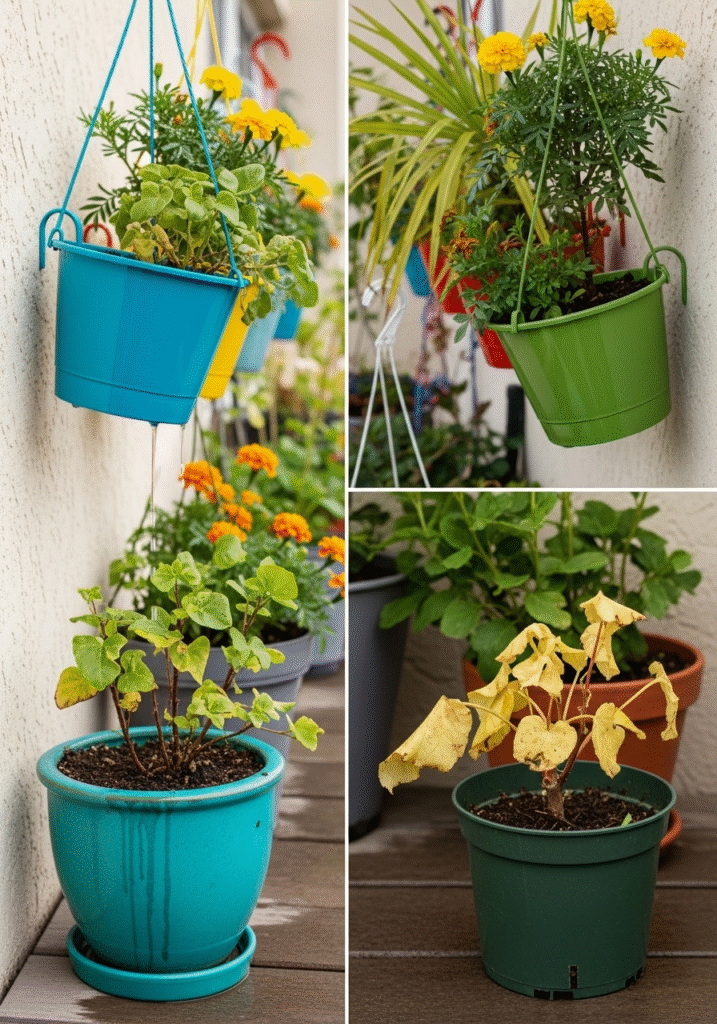
Final Thoughts
In today’s fast-paced urban world, where concrete and glass dominate, having a small pocket of nature to call your own is both a luxury and a necessity. Balcony hanging plants offer an incredible opportunity to bring beauty, greenery, and tranquility into your life—right outside your window. Whether you live in a high-rise apartment or a modest home, your balcony holds the potential to become a vibrant green escape.
What makes hanging plants so special is their ability to elevate even the smallest spaces—literally and figuratively. They free up valuable floor space, add visual depth, and create a dynamic, vertical garden that feels alive and inspiring. From cascading vines and flowering bursts of color to aromatic herbs and decorative foliage, there’s a plant for every personality and climate.
But beyond their aesthetic appeal, balcony hanging gardens offer practical benefits too:
- They improve air quality, naturally filtering pollutants.
- They offer shade, privacy, and sound insulation, especially in dense city environments.
- They contribute to a sense of calm and wellness, promoting mindfulness and a connection with nature.
The best part? You don’t need to be a seasoned gardener to get started. With a little planning, the right hanging methods, and some basic maintenance, you can enjoy a lush balcony garden regardless of your experience level or budget. There are endless combinations of DIY planter ideas, low-maintenance plant varieties, and creative display techniques that make it easy to personalize your green space.
Let your imagination guide you—combine macramé hangers with recycled containers, mix bright petunias with trailing ivy, and play with heights, colors, and textures to design a space that’s truly your own. Gardening isn’t about perfection; it’s about experimentation, growth, and joy.
Your Balcony Garden, Your Personal Oasis
Remember: your balcony is more than just an outdoor space—it’s a canvas for self-expression, relaxation, and creativity. A well-curated hanging garden turns it into a peaceful retreat where you can unwind, sip tea, read a book, or simply enjoy the gentle sway of green leaves in the breeze.
So don’t wait for the “perfect” moment. Start small if you need to. Hang a single pot, choose a low-maintenance plant, or repurpose an old container into something new. With every new leaf and bloom, you’ll build a deeper connection with your space—and with nature itself.
Whether you’re gardening for beauty, sustainability, stress relief, or all of the above, a lush balcony garden is well within your reach—one hanging planter at a time.
